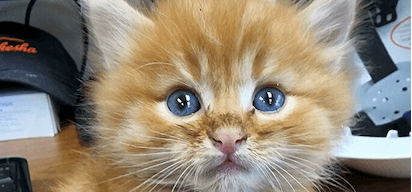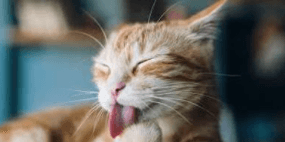by Doug Hines, publisher of CatNewsHeadlines
This business of transitioning a cat from one food to another takes a lot of intentionality and patience on your part. Be prepared for weeks and possibly months of real inconvenience for you as you continually express your dedication to your cat’s healthy future by staying the course.
The First Law of Cat Transitioning – Expect Rejection.
Law Two? The straightest path to rejection is to bring home an entire case of the new stuff.
Facing each other over the empty cat dish you think, “Will my cat eat it this time?” We’ve all been there! Transitioning your cat to eat a new food can be bewildering, challenging, confusing, daunting, disconcerting dismaying, discouraging, disheartening, dispiriting, demoralizing, frustrating, perplexing, troubling, unsettling, and upsetting.
However, there are other words which will lead you to success in transitioning your cat to a new food. The words determination, patience and perseverance come to mind.
Ready for the challenge?
Like two Japanese heavyweight sumo wrestlers stepping in to the ring, you line up across from your cat prepping yourself for the challenge. Meanwhile, season ticket-holders (your family and friends) are lining up ringside to place their bets on the final outcome.
To repeat from above, transitioning first requires patience. It also takes money. Somewhere in the transitioning process you will begin to ask yourself why you are putting, perfectly good, nutritious, expensive cat food – food your cat has rejected – down the garbage disposal. You’ll begin to ask yourself questions like, “Am I out of my mind?”
It seems like cats either have an extreme food affinity or an extreme food addiction!
If you are committed to your cat’s healthy future, live by the Star Trek® saying… “Resistance is futile.” Decide that your cat is going to convert his or her diet no matter what.
Some cats jump right in and gobble up their new food. Other cats will only nibble – sometimes. Many cats reject anything ‘different’ that is put on their dish.
Some cats are resistant to eating new foods, no matter how good the food might be for them. Cats are especially resistant to transitioning to wet food after having eaten dry food. (It seems cats just can’t resist the synthetic, chemical flavorings sprayed on dry food. They love it. When you read the words ‘synthetic, chemical flavorings’ do alarm bells start going off in your mind? Don’t be like an ostrich with your head in the sand ignoring these words. Transition from dry to wet food or your cat will suffer in the long run. Refer back to this page about Dry Food.)
Free Feeding
Most experts agree… that the first step in getting your cat to eat a new food is to stop ‘free feeding.’ Free feeding is putting out food on the plate for your cat to access anytime he or she wants. People mistakenly think that providing their cats with an ample amount of kibble all day long is the way to feed a cat. WRONG! Eliminate free feeding and set fairly consistent feeding hours for your cat(s). Most cats do best with 3-4 small meals a day.
Transitioning a cat to new food is a matter of time / amount / smell / texture / temperature.
• Give it time
You can’t just bring home one can of food and expect your cat to like it right away. It takes multiple feedings, over time, for a cat to finally accept a change in food. After all… How long has your cat been eating his or her present food? So the first element in transitioning is time. Sometimes it can take MONTHS.
• Amount/Smell
Most people say to start with small amounts of the new food – maybe a teaspoonful. I say go even smaller. Start with pea sized – maybe a half a teaspoon.
The reason for such a small amount? Before any other factor (amount/texture/temp) you are introducing your cat to a new smell and you don’t want the new smell to be overwhelming.It’s the smell/odor of the new food that a cat will encounter long before he or she takes a bite. After your cat accepts the smell, he/she may begin to nibble. Once your cat takes a nibble at the small amount of new food, he or she will undoubtedly begin to accept it as real food.
• Texture
There’s generally nothing one can do to affect the texture factor, especially if transitioning from dry to wet or raw. The only remedy for this situation is time. Give you cat time to make the changeover.
• Temperature
A seldom though about factor in transitioning is temperature. Plunk down a cold new food into your cat’s room-temperature older food and you are probably not supporting the desired effect.
You probably dislike many kinds of cold food, and the same is so for your cat(s). Put the (initial) small amount of food you have taken out of the refrigerator, put it in a small ziplock plastic bag, and dunk it in a glass of water from the hot water tap on your sink. You don’t want boiling water. Hot tap water is sufficient, and you only need to leave the plastic bag in the water for a couple of minutes.
So time, amount, smell, texture and temperature all affect this thing called ‘transitioning.’
Another thing that I have learned is to not give away rejected cat food cans too soon. The very food that my cats have turned up their noses at today may become one of their favorite foods tomorrow. You’ll see.






















